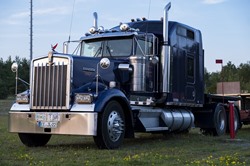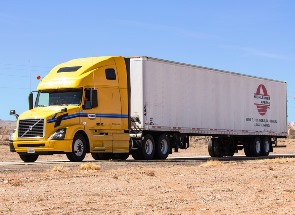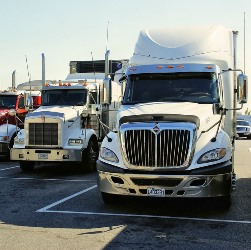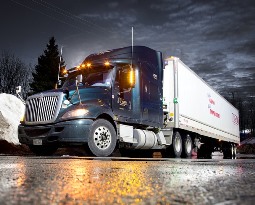How to Decide on the Right Truck Driving Classes near Freeborn Minnesota
 Congratulations on your decision to become a trucker and enroll in a truck driving school near Freeborn MN. Maybe it has always been your ambition to hit the open road while driving a monster tractor trailer. Or perhaps you have done some analysis and have discovered that an occupation as a truck driver provides excellent income and flexible work prospects. Regardless of what your reason is, it’s imperative to obtain the proper training by choosing the right CDL school in your area. When assessing your options, there are certain factors that you’ll want to consider before making your final selection. Location will certainly be important, especially if you need to commute from your Freeborn residence. The cost will also be important, but picking a school based exclusively on price is not the ideal means to make certain you’ll obtain the appropriate training. Don’t forget, your objective is to learn the knowledge and skills that will enable you to pass the CDL exams and become a professional truck driver. So keeping that objective in mind, just how do you choose a truck driving school? That is what we are going to cover in the balance of this article. But first, we are going to talk a little bit about which commercial driver’s license you will ultimately need.
Congratulations on your decision to become a trucker and enroll in a truck driving school near Freeborn MN. Maybe it has always been your ambition to hit the open road while driving a monster tractor trailer. Or perhaps you have done some analysis and have discovered that an occupation as a truck driver provides excellent income and flexible work prospects. Regardless of what your reason is, it’s imperative to obtain the proper training by choosing the right CDL school in your area. When assessing your options, there are certain factors that you’ll want to consider before making your final selection. Location will certainly be important, especially if you need to commute from your Freeborn residence. The cost will also be important, but picking a school based exclusively on price is not the ideal means to make certain you’ll obtain the appropriate training. Don’t forget, your objective is to learn the knowledge and skills that will enable you to pass the CDL exams and become a professional truck driver. So keeping that objective in mind, just how do you choose a truck driving school? That is what we are going to cover in the balance of this article. But first, we are going to talk a little bit about which commercial driver’s license you will ultimately need.
Which CDL Should You Get?
 In order to drive commercial vehicles lawfully within the United States and Freeborn MN, a driver must attain a CDL (Commercial Driver’s License). The 3 license classes that a driver can qualify for are Class A, Class B and Class C. Since the topic of this article is how to select a truck driver school, we will address Class A and B licenses. What differentiates each class of CDL is the kind of vehicle that the driver can operate in addition to the GVWR (Gross Vehicle Weight Rating) or GCWR (Gross Combination Weight Rating). Below are short explanations of the two classes.
In order to drive commercial vehicles lawfully within the United States and Freeborn MN, a driver must attain a CDL (Commercial Driver’s License). The 3 license classes that a driver can qualify for are Class A, Class B and Class C. Since the topic of this article is how to select a truck driver school, we will address Class A and B licenses. What differentiates each class of CDL is the kind of vehicle that the driver can operate in addition to the GVWR (Gross Vehicle Weight Rating) or GCWR (Gross Combination Weight Rating). Below are short explanations of the two classes.
Class A CDL. A Class A CDL is required to drive any vehicle that has a GCWR of greater than 26,000 lbs., including a towed vehicle of greater than 10,000 lbs. A few of the vehicles that drivers may be able to operate with Class A licenses are:
- Interstate or Intrastate Tractor Trailers
- Trucks with Double or Triple Trailers
- Tanker Trucks
- Livestock Carriers
- Class B and Class C Vehicles
Class B CDL. A Class B Commercial Drivers License is required to drive single vehicles having a GVWR of more than 26,000 lbs., or a GCWR of greater than 26,000 lbs. including a towed vehicle weighing up to 10,000 lbs. Several of the vehicles that drivers may be qualified to operate with Class B licenses are:
- Tractor Trailers
- Dump Trucks
- Cement Mixers
- Large Buses
- Class C Vehicles
Both Class A and Class B Commercial Drivers Licenses may also need endorsements to drive specific types of vehicles, for instance school or passenger buses. And a Class A license holder, with the appropriate needed endorsements, can drive any vehicle that a Class B licensee is authorized to drive.
Click Here to Get Free Information on Truck Driving Schools Near You!
How to Research a CDL School
 When you have decided which CDL you want to obtain, you can begin the undertaking of evaluating the Freeborn MN truck driver schools that you are looking at. As already discussed, cost and location will certainly be your primary concerns. But it can’t be stressed enough that they should not be your only concerns. Other factors, for example the reputations of the schools or the experience of the instructors are equally if not more important. So following are several additional factors that you need to research while carrying out your due diligence prior to choosing, and particularly paying for, your truck driving training.
When you have decided which CDL you want to obtain, you can begin the undertaking of evaluating the Freeborn MN truck driver schools that you are looking at. As already discussed, cost and location will certainly be your primary concerns. But it can’t be stressed enough that they should not be your only concerns. Other factors, for example the reputations of the schools or the experience of the instructors are equally if not more important. So following are several additional factors that you need to research while carrying out your due diligence prior to choosing, and particularly paying for, your truck driving training.
Are the Schools Accredited or Certified ? Not many trucking schools in the Freeborn MN area are accredited because of the stringent process and expense to the schools. However, certification is more prevalent and is provided by the Professional Truck Driver Institute (PTDI). A school is not obligated to become certified, but there are certain advantages. Potential students know that the training will be of the highest standard, and that they will be given an ample amount of driving time. For example, PTDI calls for 44 hours of real driving time, not ride-alongs or simulations. So if a school’s course is certified (the course, not the school is certified), students know that the training and curriculum will fulfill the very high benchmarks set by PTDI.
How Long in Operation? One clue to help determine the quality of a trucking school is how long it has been in business. A negatively ranked or a fly by night school normally will not stay in business very long, so longevity is a plus. However, even the best of Freeborn MN schools had to begin from their opening day of training, so consider it as one of several qualifications. You can also ask what the school’s history is regarding successful licensing and employment of its graduates. If a school won’t share those stats, look elsewhere. The schools should also maintain relationships with regional and national trucking firms. Having a large number of contacts not only points to an excellent reputation within the trade, but also boosts their job placement program for students. It also wouldn’t be a bad idea to contact the Minnesota licensing department to verify that the CDL trucking schools you are researching are in compliance.
How Effective is the Training? As a minimum requirement, the schools should be licensed in Minnesota and hire teachers that are trained and experienced. We will cover more about the teachers in the next segment. In addition, the student to instructor ratio should not be higher than 4 to 1. If it’s any greater, then students will not be receiving the individual instruction they will need. This is particularly true concerning the one-on-one instruction for behind the wheel training. And look out for any school that claims it can teach you to drive trucks in a relatively short time frame. Training to be a truck driver and to drive a tractor trailer professionally requires time. Most Freeborn MN schools provide training programs that range from three weeks to as long as 2 months, based on the class of license or kind of vehicle.
How Experienced are the Instructors? As earlier mentioned, it’s imperative that the teachers are qualified to teach driving techniques and experienced as both drivers and instructors. Even though several states have minimum driving time criteria to be certified as an instructor, the more successful driving experience an instructor has the better. It’s also vital that the teachers keep up to date with industry developments or any new laws or changes in regulations. Assessing instructors might be a bit more intuitive than other standards, and possibly the best method is to visit the school and talk to the instructors face to face. You can also speak with some of the students completing the training and ask if they are satisfied with the quality of instruction and the teacher’s qualification to train them.
Enough Driving Time? Above all else, a good truck driving school will furnish lots of driving time to its students. After all, isn’t that what it’s all about? Driving time is the real time spent behind the wheel driving a truck. While the use of simulators and ride-a-longs with other students are necessary training methods, they are no substitute for actual driving. The more instruction that a student gets behind the wheel, the better driver he or she will be. Although driving time can vary between schools, a reasonable benchmark is a minimum of 32 hours. If the school is PTDI certified, it will provide a minimum of 44 hours of driving time. Get in touch with the Freeborn MN schools you are considering and find out how much driving time they furnish.
Are they Independent or Captive ? You can receive free or discounted training from certain truck driving schools if you make a commitment to drive for a specified carrier for a defined period of time. This is what’s known as contract training, and the schools that offer it are called captives. So instead of maintaining affiliations with many different trucking lines that they can place their graduates with, captives only work with one company. The tradeoff is receiving free or less expensive training by giving up the flexibility to initially work wherever you choose. Naturally contract training has the potential to reduce your income opportunities when starting out. But for many it may be the best way to receive affordable training. Just be sure to inquire if the Freeborn MN schools you are looking at are independent or captive so that you can make an informed decision.
Is there CDL Testing Onsite? There are several states that will allow third party CDL testing onsite of truck driver schools for its graduates. If onsite testing is allowed in Minnesota, find out if the schools you are reviewing are DMV certified to offer it. One benefit is that it is more accommodating than competing with graduates of competing schools for test times at Minnesota testing centers. It is moreover an indicator that the DMV regards the approved schools to be of a superior quality.
Are the Class Times Convenient? As formerly mentioned, CDL training is only about one to two months long. With such a brief term, it’s essential that the Freeborn MN school you choose offers flexibility for both the scheduling of classes and the curriculum. For example, if you’re having a hard time learning a certain driving maneuver, then the instructor should be willing to commit more time with you until you have it mastered. And if you’re still working while attending training, then the class scheduling must be flexible enough to fit in working hours or other commitments.
Is Job Assistance Offered? As soon as you have obtained your commercial driver’s license after graduating from trucking school, you will be eager to start your new profession. Verify that the schools you are contemplating have job placement programs. Find out what their job placement rate is and what average salary their graduates start at. Also, find out which national and local trucking companies their graduates are referred to for employment. If a school has a poor job placement rate or not many Freeborn MN employers hiring their grads, it might be a sign to search elsewhere.
Is Financial Assistance Given? Trucking schools are much like colleges and other Freeborn MN area vocational or trade schools when it comes to loans and other forms of financial aid being offered. Ask if the schools you are assessing have a financial assistance department, or at a minimum someone who can help you get through the options and forms that must be completed.
Best Trucking Schools Freeborn Minnesota
 Selecting the right truck driving school is an important first step to beginning your new occupation as a long distance or local truck driver. The skill sets taught at school will be those that mold a new career behind the wheel. There are many options available and understanding them is crucial if you are going to succeed as an operator. You originally came to our website because of your interest in Best Trucking Schools and wanting information on the topic CDL Driving School Near Me. But first and foremost, you must receive the appropriate training in order to drive a large commercial vehicle in a professional and safe fashion. If you are short on cash or financing, you might want to consider a captive school. You will pay a lower or even no tuition by agreeing to drive for their contracted carrier. Or you can enroll in an independent truck driver school and have the the freedom to drive for the trucking company of your choosing, or one of several affiliated with the school. It’s your choice. But no matter how you receive your training, you will soon be joining a profession that helps America move as a professional truck driver in Freeborn MN.
Selecting the right truck driving school is an important first step to beginning your new occupation as a long distance or local truck driver. The skill sets taught at school will be those that mold a new career behind the wheel. There are many options available and understanding them is crucial if you are going to succeed as an operator. You originally came to our website because of your interest in Best Trucking Schools and wanting information on the topic CDL Driving School Near Me. But first and foremost, you must receive the appropriate training in order to drive a large commercial vehicle in a professional and safe fashion. If you are short on cash or financing, you might want to consider a captive school. You will pay a lower or even no tuition by agreeing to drive for their contracted carrier. Or you can enroll in an independent truck driver school and have the the freedom to drive for the trucking company of your choosing, or one of several affiliated with the school. It’s your choice. But no matter how you receive your training, you will soon be joining a profession that helps America move as a professional truck driver in Freeborn MN.
Truck On in These Other Minnesota Locations
Freeborn County, Minnesota
Freeborn County lies on Minnesota's border with Iowa. The Shell Rock River flows southward from Albert Lea Lake in central Freeborn County, crossing into Iowa. Turtle Creek flows eastward through the upper eastern part of the county, crossing into Mower County. The terrain is hilly and etched with drainages and gullies. The Le Sueur River, a tributary of the Minnesota River, begins in the northern part of the county and flows northward into Waseca County. The available land is devoted to agriculture.[6] The terrain generally slopes to the south and east. although the highest point is near the northeast corner, at 1,296' (395m) ASL.[7] The county has a total area of 722 square miles (1,870 km2), of which 707 square miles (1,830 km2) is land and 15 square miles (39 km2) (2.1%) is water.[8]
As of the 2000 United States Census, there were 32,584 people, 13,356 households, and 9,015 families in the county. The population density was 46.1/sqmi (17.8/km²). There were 13,996 housing units at an average density of 19.8/sqmi (7.64/km²). The racial makeup of the county was 95.22% White, 0.24% Black or African American, 0.20% Native American, 0.55% Asian, 0.02% Pacific Islander, 2.92% from other races, and 0.85% from two or more races. 6.29% of the population were Hispanic or Latino of any race. 34.8% were of Norwegian, 26.2% German and 5.8% Danish ancestry.
There were 13,356 households out of which 29.10% had children under the age of 18 living with them, 56.50% were married couples living together, 7.50% had a female householder with no husband present, and 32.50% were non-families. 28.20% of all households were made up of individuals and 14.00% had someone living alone who was 65 years of age or older. The average household size was 2.40 and the average family size was 2.92.
